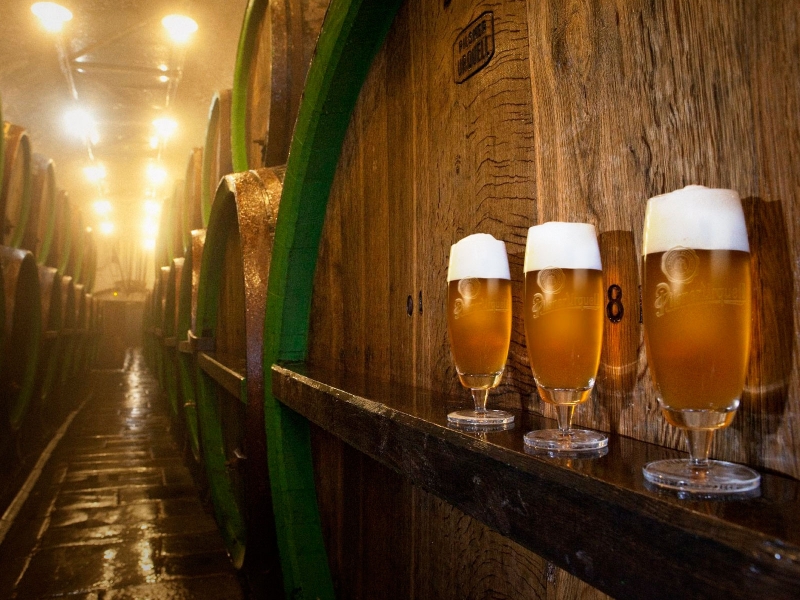SOLUTION FOR BEER WASTEWATER TREATMENT

Beer is a beverage that contains ethanol and carbonic acid, made from malt, hops, yeast and water. Brewing includes processes such as brewing, fermenting, brewing, filtering and bottling. Before fermenting into alcohol, the malt starches are converted into hydrolyzed sugars.
Composition of solid waste (beer residue) and wastewater generated from brewing, fermentation, in beer basins and filters, from containers, cleaning bottles.
The source of wastewater from breweries is mainly from cleaning equipment and factories. Wastewater is generated from brewing process with the rate of 4 - 11m3 of waste water / m3 of products, the average is 5-6m3, of which about 2/3 of wastewater is from the manufacturing process and 1 / 3 is water used for sanitary purpose.
1. The main sources of discharge:
- Chilled water, condensed water
- Wastewater from cooking, saccharizing units, mainly from cleaning containers, basins, floors; therefore, it contains malt, starch, flower residues, organic substances, etc.
- Wastewater from fermentation bunkers that is used for cleaning fermentation equipment, basins, pipes, floors, workshops, etc. containing yeast residues, and organic matter.
- Water from washing bottles with high PH and high temperature
- Wastewater
Pollution levels in each source of discharge are very different and depend on the production technology and management. In the common wastewater stream, the typical pollution level for the components has the following average values (mg / l):
|
HC (*) |
TSS |
P (Insoluble) |
COD |
BOD |
pH |
|
1,561 |
>2000 |
7-30 |
1500-3000 |
1100-1500 |
5-11 |
(*) HC is the organic component in Total suspended solids
2. Beer wastewater treatment processes are common at factories in Vietnam
Equalization basin -> PH adjustment -> Primary sedimentation -> UASB -> Aerobic (1 or more aerobic basins) -> Secondary sedimentation -> Sterilization -> Discharge into the environment
3. Common problems:
- Sludge is suspended or cannot settle
- Microorganisms are unstable, often die and must be re-implanted
- The design does not meet the capacity or standard
- The system generates many odors
- Operators have difficulty maintaining the water treatment quality of the treatment system
4. For an effective processing system, two factors need to be considered:
- Standard technology design: volume of the treatment basins is not necessarily large, it is important to match the pollution concentration of each parameter in wastewater and create an appropriate environment for microbiological development.
- The technological plan must create favorable conditions for the operator to observe and operate the system; tools must be equipped for the operator to perform required jobs.
If your business is interested in solution to inlet water treatment, or has a demand for ion exchange materials, please contact NGO via phone number (024) 3566 8225 or email office@8ngo.com for direct consultation.
-
 Wastewater treatment
Wastewater treatment
-
 A standard domestic wastewater
A standard domestic wastewater
-
 B standard domestic wastewater
B standard domestic wastewater
-
 Pig Farm Wastewater
Pig Farm Wastewater
-
 Textile dyeing wastewater
Textile dyeing wastewater
-
 Paper industry wastewater solution
Paper industry wastewater solution
-
 Textile Dyeing Wastewater & Industrial Washing
Textile Dyeing Wastewater & Industrial Washing
-
 Slaughter wastewater treatment solution
Slaughter wastewater treatment solution
-
 Aquaculture wastewater
Aquaculture wastewater
-
 Starch wastewater
Starch wastewater
-
 Petroleum wastewater
Petroleum wastewater
-
 Beer wastewater
Beer wastewater
-
 Other industrial wastewaters
Other industrial wastewaters
-
 BioPM - Organic Industrial wastewater treatment solution
BioPM - Organic Industrial wastewater treatment solution
-
 MBR solutions
MBR solutions
-
 Conventional activated sludge (CAS)
Conventional activated sludge (CAS)
-
 Moving bed biofilm reactor (MBBR)
Moving bed biofilm reactor (MBBR)
-
 Anaerobic- Anoxic-Aerobic (AAO)
Anaerobic- Anoxic-Aerobic (AAO)
-
 Sequencing batch reactor (SBR)
Sequencing batch reactor (SBR)
-
 Physical & Chemical methods
Physical & Chemical methods
-
 Supply water treatment
Supply water treatment
-
 Cooling system water
Cooling system water
-
 Water treatment for food and Beverage production
Water treatment for food and Beverage production
-
 Ultra pure water supply solution for electronic industry
Ultra pure water supply solution for electronic industry
-
 Pure water supply for pharmaceutical manufacturers
Pure water supply for pharmaceutical manufacturers
-
 Water Supply treatment with ion exchange method
Water Supply treatment with ion exchange method
-
 Ordor Treatment
Ordor Treatment

